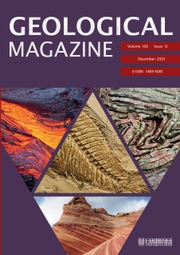Article contents
VI.—The Upper Trias of Leicestershire
Published online by Cambridge University Press: 01 May 2009
Extract
A study of the local stratigraphy, tectonics, petrography, and palæontology leads to some conclusions as to the physiography of the epoch in this district. Even studied as a detached area it may be noticed that the Bunter or pebble deposits are west of the sandstones and marls. From the fact that the eastern limits of the first two are west of the marls, and the second (sandstones) west of the pebbles, and from the evidence of other areas, it appears that this purely local west to east succession is applicable to the whole British area, and it is well known that each member thins from north-west to south-east (as a whole). This is the sequence typical of aqueous deposits, and particularly of delta deposits, and at the same time indicates (in part) the direction from which the sediment came.
- Type
- Original Articles
- Information
- Copyright
- Copyright © Cambridge University Press 1916
References
page 360 note 2 See Harrison, Ussher, McKenny Hughes, and Royal Coal Commission Reports, etc.
page 361 note 1 Grey beds more arenaceous and calcareous, of higher specific gravity than the red beds.
page 361 note 2 Carried further out by the increased velocity of the current.
page 364 note 1 Accepting Dr. Moody's view.
page 364 note 2 Following deposition of red colour.
page 368 note 1 At that time the Needwood outlier was not known.
page 369 note 1 “It is not meant that even the highest beds of the New Red Sandstone ever attained the same general height over the surrounding country which they have in the Forest, as they would naturally be deposited on a gentle slope, rising higher on the sides of the hills than elsewhere.”
- 1
- Cited by


